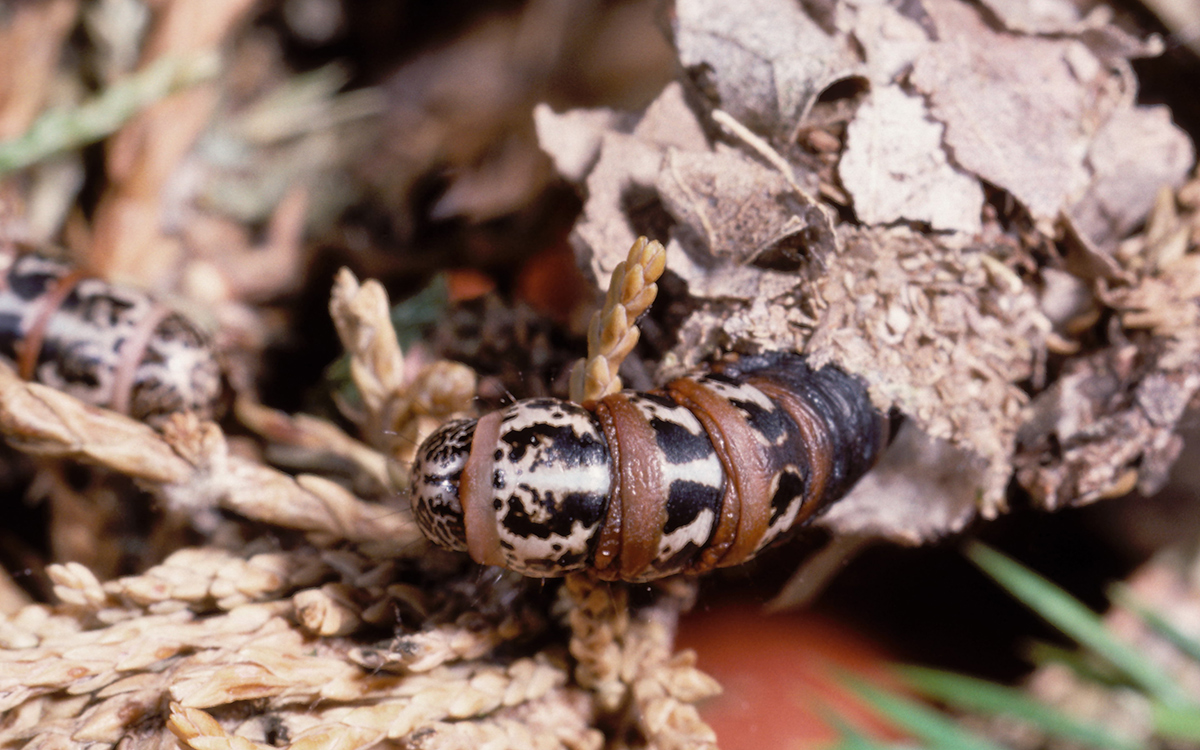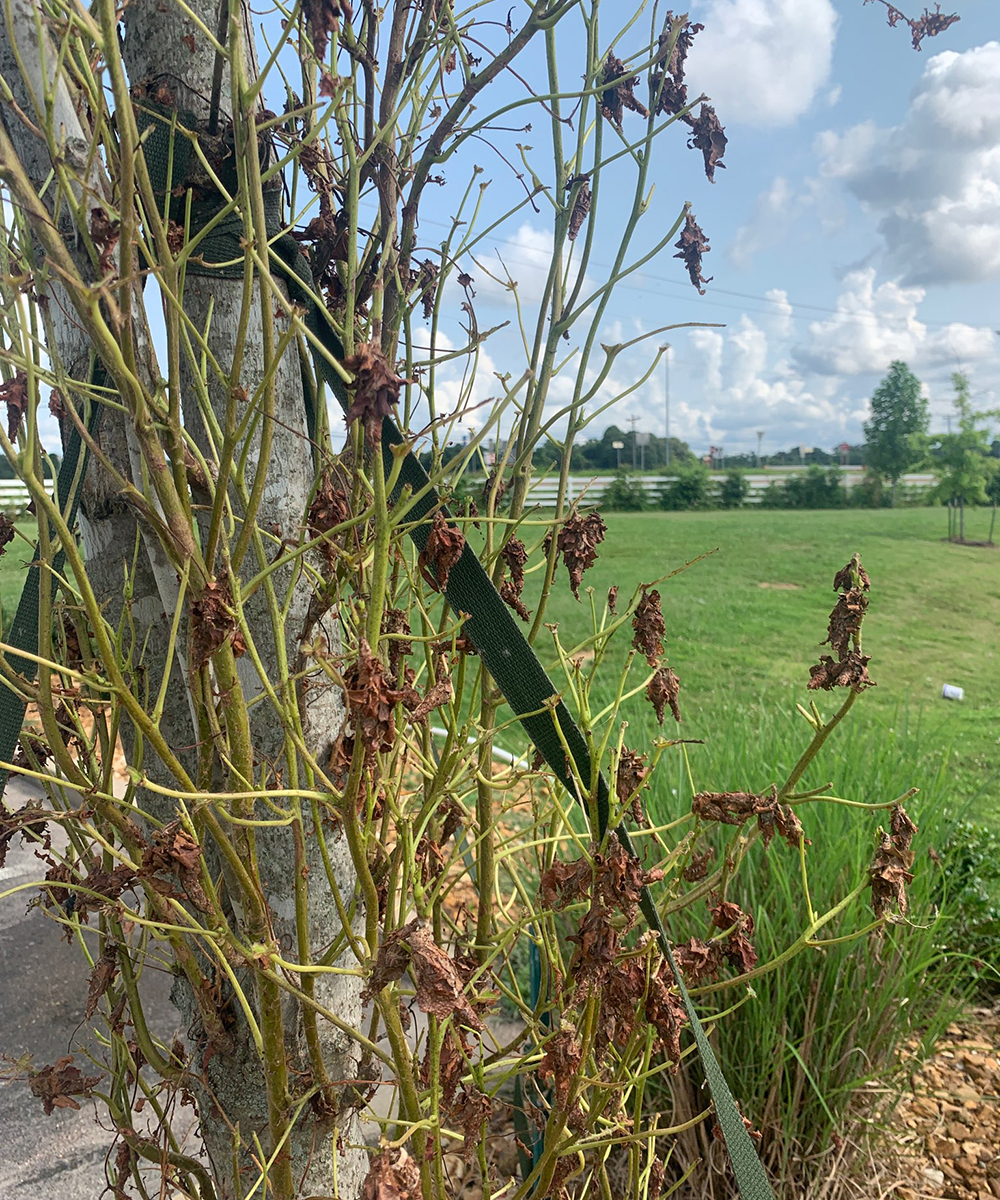
Easily one of the most asked-about pests are bagworms. The evergreen bagworm (Thyridopteryx ephemeraeformis) is an insect that makes distinctive spindle-shaped bags during its larval stage. If left uncontrolled, larval feeding can lead to considerable defoliation of many major garden plants. It can also cause “bronzing” of trees in which formerly green sections become brown and dead. Bagworms mostly feed on evergreen trees, but deciduous trees can also be targets. In the Southeast, bagworms are particularly fond of junipers (Juniperus spp. and cvs., Zones 2–10), cedars (Cedrus spp. and cvs., Zones 5–9), Leyland cypress trees (Cuprocyparis leylandii, Zones 6–10), pines (Pinus spp. and cvs., Zones 2–9), and arborvitaes (Thuja spp. and cvs., Zones 2–8). They even show up on Japanese maples (Acer palmatum and cvs., Zones 5–9) and other maples (Acer spp. and cvs., Zones 3–9) from time to time. In my experience, arborvitaes are toward the top of their list. Because arborvitaes are used extensively for accents and in screening, gardeners in the Southeast need to be aware of this potentially damaging pest.

The life cycle of a bagworm
The good news (if there is any) is that there is only one generation of bagworms per year. Eggs overwinter every year in the bags of female bagworms. There can be hundreds of eggs in every bag. In the Southeast, eggs can hatch as early as April. After hatching, larvae go right to work creating silken shelters and eating the foliage of their host plant. At this stage, bagworms are not stuck in place. They are highly mobile in their search for food. As the larvae grow, so does the bag they carry in search of food. Their bag acts as shelter and protection in this stage. When disturbed, they will retreat into their bag. During the late stages of development (August in the Southeast), the larvae permanently secure their bags to a branch and transform into pupae. This process normally lasts 7 to 10 days. The male moths emerge about a month after they pupate. Male bagworm moths are a grungy blackish brown and have hairy bodies and clear wings. The female never leaves the bag. After mating, eggs are deposited within the abdomen of the female before she dies. What a life!

When to treat bagworms
The management of bagworms is considered somewhat difficult. Scouting on susceptible species is the most important step in controlling bagworms. Looking for bags in the fall and early winter and handpicking them are the most important steps. Soak bags in soapy water for several hours before disposal to kill eggs. You should also start looking for them in May and June when they start to be active. This is a good time to start treating them. The bigger you let the bagworms get, the harder they are to control, and the more damage occurs.
How to treat bagworms
There are parasitic wasps known to attack these pests. You can increase the presence of these wasps by planting a variety of flowering plants near highly susceptible host plants. Bt (Bacillus thuringiensis) sprays can work during the young larval stages. Bt is a bacterium that is nontoxic to humans and animals. Neem oil and Spinosad have also shown to be effective against bagworms. Hand removal of bags, as previously stated, is also an option. As a last resort, you can use systemic insecticides as long as you know from a proper extension service diagnosis that you are treating the proper pest and follow the instructions carefully; however, systemic insecticides are not without health and environmental risks.
Educate yourself
Bagworms are native to North America. They mostly occur in the eastern and southeastern United States. When there is a heavy infestation, they often go unnoticed until extensive damage has been done to ornamental plants. Again, scouting for bags in the fall and larvae in the late spring is the key to controlling them. Bagworms have natural predators, and their populations fluctuate from year to year. In the home landscape, the species of greatest concern are evergreen conifers that might have a hard time recovering if defoliated.
For more on controlling regional pests, check out:
- Pest Control for the Southeast: Ambrosia Beetles
- Pest Alert: Kudzu Beetle
- Emerald Ash Borer Damage and Prevention
- How to Fight Back Against Japanese Beetles
And for more Southeast regional reports, click here.
—Andy Pulte is a faculty member in the plant sciences department at the University of Tennessee.
Fine Gardening Recommended Products

ARS Telescoping Long Reach Pruner
Fine Gardening receives a commission for items purchased through links on this site, including Amazon Associates and other affiliate advertising programs.

DeWalt Variable-Speed Cordless Reciprocating Saw with 6-Piece Saw Blade Set
Fine Gardening receives a commission for items purchased through links on this site, including Amazon Associates and other affiliate advertising programs.
- 18.31 x 6.13 x 4 inches
- 1-1/8-inch stroke length
- Variable speed trigger with 0-3000 spm
- DW4856 Metal/Woodcutting Reciprocating Saw Blade Set, 6-Piece

Pruning Simplified: A Step-by-Step Guide to 50 Popular Trees and Shrubs
Fine Gardening receives a commission for items purchased through links on this site, including Amazon Associates and other affiliate advertising programs.



















Comments
Log in or create an account to post a comment.
Sign up Log in